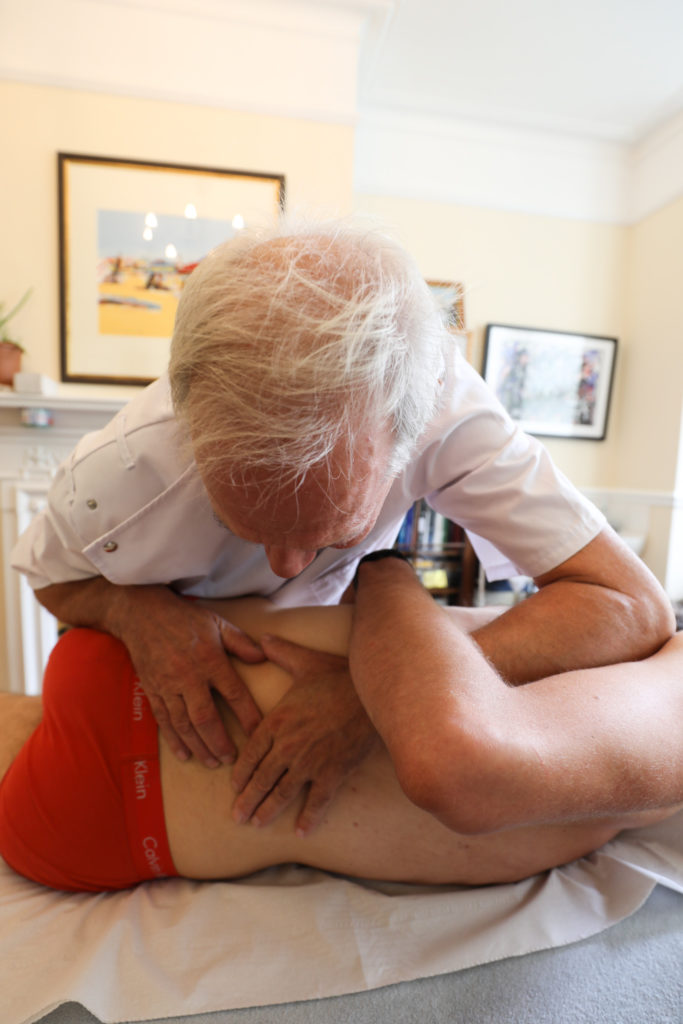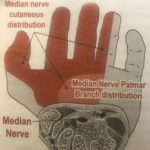
written by Laurie Melrose-Doering, Osteopath
Osteopaths and chiropractors are famed for using spinal manipulations – commonly referred to as ‘back cracking or clicking’ or ‘spine popping’.
So, have you ever wondered why on earth, osteopaths and chiropractors crack backs? Why using a foam roller cracks your back, or why your lower back cracks when you twist? Or simply why your back clicks a lot?
If yes, you may find this article interesting.
I will explain what happens when your back cracks, clicks, or pops. I will also explain why targeted spinal manipulations are used in osteopathy and chiropractic medicine.
What happens during back cracking?
Thankfully, the cracking sound that is often heard after a manipulation has nothing to do with a dislocated vertebra or joint that is put back into place. Rather, scientists believe that the gas trapped within the joint is released on movement of the joint, and that this is what causes the cracking sound. A manipulation of a cervical vertebra seems louder to the patient because of the proximity of the ears. This very good Ted Talk gives a better explanation.
Osteopathic theory behind spine cracking
The aim of a spinal manipulation, also known as a high velocity thrust (HVT), is the correction of a vertebra relative to the one below.
(The following goes into great detail and may not be of interest to everyone. I was taught the osteopathic theory behind spine cracking by Stephen Pirie, an osteopathic maestro in manipulations. He had 50 years of experience as an osteopath when I was lucky enough to be taught by him at the European School of Osteopathy.)
Back cracking – Anatomy
Each zygapophyseal vertebral joint, also known as the facet joint, is spanned by segmental muscles (segmental means the muscles run between the two segments, i.e. the two vertebrae).
These tiny muscles are interspinalis (extends the facet joint), left and right intertransversarii (side-bend the facet joint left and right), and left and right rotatories (rotate the facet joint left and right).
Back cracking – Neurology
These intrinsic back muscles have a high number of Golgi tendon organs, and we therefore know that they are highly proprioceptive. They have to be because the primary balance mechanism of the body resides in the joints, especially the spine.
The other inputs to the cerebellum, responsible for balance, are vision and the vestibular apparatus of the inner ear. (The role of the cerebellum is probably best understood when you visualise what people struggle with when they are drunk).
Osteopathy & back cracking – the importance of the spine’s proprioceptive system
The following underlines the importance of the proprioceptive system:
Before antibiotics, mastoiditis was very serious (as it could lead to meningitis, encephalitis, and death) and would often necessitate removal of the mastoid process and semicircular canals.
On rare occasions, mastoiditis was bilateral, and the surgeon was faced with the dilemma that if they removed both semicircular canals the patient might never regain any sense of balance, however, the alternative was a probable death sentence.
The patients, somehow, recovered their sense of balance almost immediately. And this was irrespective of whether their eyes were open or closed (the possibility that the balance was due to visual input was thereby eliminated).
Cruelly, to prove this point, scientists removed the intrinsic segmental muscles from dogs’ spines – they were never able to walk again.
So it is that the central nervous system constantly receives input from the Golgi tendon organs of every vertebral segment via the spinocerebellar tract – every movement we do will trigger this neurological measuring in order to allow us to maintain balance. This neurological activity results in exquisite fine-tuning of movements of all the muscles of the spine. The body can thereby ensure that the spine compensates to movement so that the eyes are kept horizontal and we maintain our balance.
Back cracking – why osteopaths and chiropractors crack backs
In a somatic dysfunction, previously known as an ‘osteopathic lesion’, a vertebra is in dysfunction because the intrinsic segmental muscles are shortened on one side and lengthened on the other. Because the vertebral column acts as a whole, the other vertebrae are then required to compensate for this restriction.
When an osteopath or chiropractor manipulates the spine, he or she aims to resolve the somatic dysfunction by lining up the opposite vectors, before then applying a thrust.
Therefore, a manipulation is much more subtle than simply resolving a restriction – as important as resolving a restriction is. By reversing the vectors (lengthening the shortened fibres and shortening the lengthened fibres) a feedback loop is created that allows ‘neurological reintegration’. A manipulation (correction) of one vertebral joint therefore has an effect on the whole spine.
The fact that a focussed neurological input can effect the entire spine is a further example of the osteopathic principle that the body has self-healing mechanisms that can be triggered by a small intervention.
Is it bad to crack your back repeatedly?
I would not recommend it.
Many people enjoy cracking their backs, as it gives them a short-term ‘release’. But if you feel the urge to constantly crack your neck or back, it may indicate that a joint is out of alignment or in dysfunction.
Repeated self-administered cracking is likely to target the joint that is moving too much already. Through constant stretching of the same joint capsule, this will over time make the joint even more hypermobile. If you are constantly clicking your upper or lower back, you may want to see an osteopath who can correct the dysfunctional joint.
Some people get a different type of sound, a kind of grinding sound called crepitus. This may indicate degenerative disc disease, which may come on after a herniated disc.
Although crepitus usually indicates a degree of structural joint change, it can be exacerbated by a treatable dysfunction. I would therefore suggest seeing an osteopath. Even in the case of structural change to joints, osteopathy can often help.
What about popping knuckles?
Although popping knuckles is not the end of the world, I would not recommend – for the same reason as above. After a while, your joint capsule and ligaments are likely to stretch, and you will feel the urge to crack your knuckles more often.
I must add at this point that popping sounds are not always due to joints. They can also be due to tendons attaching to the shoulder blade or the thigh bone pinging over other anatomical structures. Again, it could be because something is out of alignment, or it could be due to shortened muscles.
Alternatives to back cracking
Although the crack of a professional spinal manipulation does not cause pain, some patients will be uncomfortable with the idea of a loud click or cracking sound.
These patients will be relieved to hear that, although I find manipulations a very valuable technique, the overall goal of resolving a somatic dysfunction is not at all dependent on a cracking the spine. During my training in applied kinesiology when I was a 3rd-year student at the European School of Osteopathy, I learned alternative techniques which are as effective.
To book an Osteopathy appointment in New Malden or in Marylebone, phone 020 8942 3148 or contact Aston Clinic London.
Aston Clinic London is a third-generation complementary health clinic based in New Malden and serves the local areas of Kingston, Wimbledon, Raynes Park, Surbiton, Chessington, Worcester Park, Sutton and other areas of southwest London and Surrey.
Aston Clinic London also offers Osteopathy and Herbal Medicine in Marylebone, Central London.

